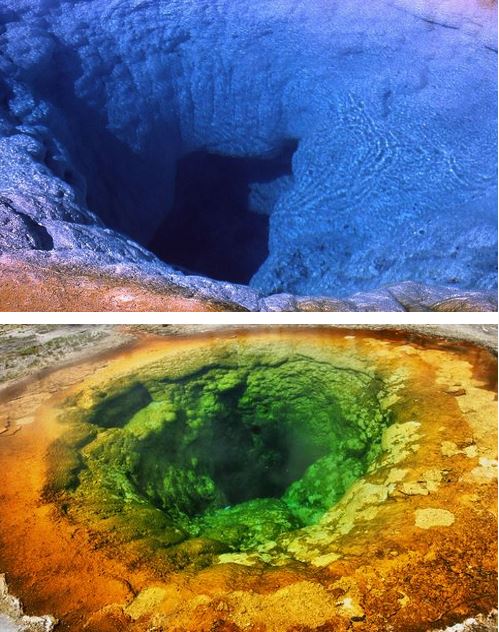The Morning Glory Pool, a hot spring in the Upper Geyser Basin of Yellowstone National Park, once had beautiful crystal clear water surrounded by blue rock. After decades of being used as a wishing well, with literally millions of coins thrown into it, as well as other debris, it is now a psychedelic green.
Morning Glory now has the nickname Fading Glory, because of its transformation from what was once a glorious hot spring into a surreal green and yellow bacteria-infested basin.
It was named Morning Glory by Mrs E. N. McGowan, wife of the Assistant Park Superintendent in 1883. She named it ‘Convolutus’ – the Latin name for the Morning Glory Flower, which the spring resembled. The term ‘Morning Glory Pool’ had become common usage in the park, and several guidebooks started using the nickname more than 120 years ago.

‘Morning Glory’ with its beautiful clear blue water in 1966. It has turned into a yellow-green ‘Faded Glory’ today.
In the 1940s one million tourists would visit Yellowstone National Park each year, compared to nearly three million today.
Coins, and sadly a great deal of rubbish and natural debris have clogged up several entryways, which has resulted in a rapid accumulation of bacteria. It is the bacteria which give the pool its current green-yellow hue.
The blocked entryways have deprived the pool of its underground heat source, which lowered the temperature of the spring to a range habitable to photosynthetic microorganisms. These microorganisms were probably never there before, Adam Hoffman writes in Science Friday.
On rare occasions the spring cleans itself out following an earthquake or nearby seismic activity, when it erupts as a geyser. Park officials have tried several times to induce eruptions to clear the pool of debris and unblock the entryways, unfortunately with disappointing results.

The spring got its nickname because it resembled the blue hue of the Morning Glory flower.
Recently, Yellowstone was in the news as a possible annihilator of all human civilization if its “supervolcano” erupted. The Yellowstone Caldera is a volcanic caldera (a cauldron-like volcanic feature) and supervolcano in Yellowstone National Park. The caldera measures approximately 34 by 45 miles (55 by 72 km). It formed during the last three super-eruptions over the past 2.1 million years.
